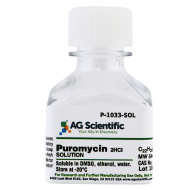Puromycin is an aminonucleoside antibiotic produced by the bacterium Streptomyces alboniger. It inhibits protein synthesis by disrupting peptide transfer on ribosomes causing premature chain termination during translation.
What is Puromycin?
 Puromycin is an aminonucleoside antibiotic produced by the bacterium Streptomyces alboniger. It inhibits protein synthesis by disrupting peptide transfer on ribosomes causing premature chain termination during translation. It is a potent translational inhibitor in both prokaryotic and eukaryotic cells. Resistance to puromycin is conferred by the puromycin N-acetyl-transferase gene (pac) from Streptomyces. Puromycin has a fast mode of action, causing rapid cell death at low antibiotic concentrations.
Puromycin is an aminonucleoside antibiotic produced by the bacterium Streptomyces alboniger. It inhibits protein synthesis by disrupting peptide transfer on ribosomes causing premature chain termination during translation. It is a potent translational inhibitor in both prokaryotic and eukaryotic cells. Resistance to puromycin is conferred by the puromycin N-acetyl-transferase gene (pac) from Streptomyces. Puromycin has a fast mode of action, causing rapid cell death at low antibiotic concentrations.
Antitumor Effect:
Puromycin has been tested against a variety of experimental tumors in various animals. As might be expected, a range of effects from the destructive or inhibitory to mild or no activity was obtained, depending upon the type of tumor and dosage. In some cases toxicity accompanied carcinostatis, since peak activity was only apparent at maximum tolerated doses. Puromycin showed significant cytotoxicity in vitro against a series of tissue cultures derived from normal and neoplastic human and animal cells. In an agar plate assay procedure for anti-tumor agents, which employed four human cell lines and sarcoma 180 of mouse origin, it was found that the human cell lines were about 2-4 times more sensitive to puromycin than was sarcoma 180 (Schuurmans et al. 1961).Mammalian cells:
The working concentrations of puromycin for mammalian cell lines range from 1 to 10 µg/ml. It is recommended that an initial experiment be done to determine the optimal concentration of puromycin required to kill your host cell line. Puromycin quickly kills eukaryotic cells that do not contain the pac gene. Dying cells detach from the plates allowing easy and early identification of transformant clones. Suggested working conditions for selection in some mammalian cells are listed below:| Cell line | Species |
Tissue |
Culture medium |
Puromycin (µg/ml) |
| 293 | Human |
Tranformed primary embryonal kidney |
DMEM |
3 |
| HeLa | Human |
Epitheloid carcinoma, cervix |
DMEM |
3 |
| B16 | Mouse |
Melanoma |
RPMI |
1-3 |
| PC1.0 | Hamster |
Pancreatic adenocarcinoma |
RPMI |
10 |
Escherichia coli:
Puromycin-resistant transformants are selected in LB agar medium supplemented with 125 µg/ml of puromycin. But use of puromycin for E. coli selection requires precise pH adjustment and also depends on which strain is selected. Plates containing puromycin are stable for 1 month when stored at 4°C.
Recognition of the puromycin by E. coli L/F-transferase. (A) Chemical structure of puromycin (left) and that of the 3'-ends of Leu-tRNALeu and Phe-tRNAPhe (middle and right, respectively). The amino-acid moiety and the base moiety are colored pink and blue, respectively. (B) |Fo-Fc| omit map of puromycin (contour level 3.0 ). (C) Recognition of the p-methoxybenzyl group and the puromycin base by the hydrophobic pocket, as shown by a surface model. (D) Ribbon model of (C). The hydrophobic amino acid involved in the recognition of the p-methoxybenzyl group and the base moiety of puromycin are colored green and blue, respectively. (E) The C-shaped edge of the hydrophobic pocket is composed of continuous amino-acid residues (Gly155-Glu156-Ser157-Met158; colored yellow and highlighted). The
). (C) Recognition of the p-methoxybenzyl group and the puromycin base by the hydrophobic pocket, as shown by a surface model. (D) Ribbon model of (C). The hydrophobic amino acid involved in the recognition of the p-methoxybenzyl group and the base moiety of puromycin are colored green and blue, respectively. (E) The C-shaped edge of the hydrophobic pocket is composed of continuous amino-acid residues (Gly155-Glu156-Ser157-Met158; colored yellow and highlighted). The  -,
-,  - and
- and  -carbons of puromycin are also shown.
-carbons of puromycin are also shown.

